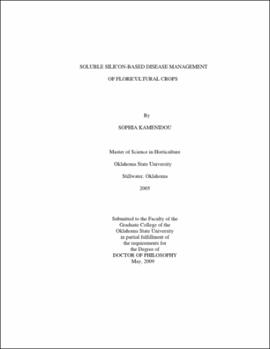| dc.contributor.advisor | Smith, Mike | |
| dc.contributor.author | Kamenidou, Sophia | |
| dc.date.accessioned | 2013-12-10T18:04:35Z | |
| dc.date.available | 2013-12-10T18:04:35Z | |
| dc.date.issued | 2009-05 | |
| dc.identifier.uri | https://hdl.handle.net/11244/7733 | |
| dc.description.abstract | Scope and Method of Study: The goal of this research was to assess the efficacy of various forms and applications of soluble silicon (Si), both alone and in combination with two rates of registered fungicides, to control three economically important fungal diseases that affect greenhouse production. The three diseases assessed were as follows: powdery mildew of zinnia and sunflower caused by Golovinomyces (=Erysiphe) cichoracearum, Phytophthora root rot of gerbera caused by Phytophthora drechsleri, and gray mold of sunflower caused by Botrytis cinerea. | |
| dc.description.abstract | Findings and Conclusions: | |
| dc.description.abstract | Powdery mildew study: In zinnia, Si supplementation reduced powdery mildew severities three- to four-fold after two weeks and two- to three-fold after three weeks. Silicon supplementation of zinnia, when combined with myclobutanil treatments, also appeared to synergistically suppress powdery mildew severity two-fold and prolong fungicide-mediated disease suppression to three weeks. In sunflower, Si supplementation suppressed powdery mildew severities two- to three-fold after two weeks and around 1.5-fold after three weeks. Myclobutanil suppressed powdery mildew of sunflower all three weeks. | |
| dc.description.abstract | Phytophthora root rot study: Mefenoxam suppressed Phytophthora root rot of greenhouse produced gerbera. Five weekly potassium silicate substrate drenches delayed disease development, but overall Si supplements did not provide protection against this disease. | |
| dc.description.abstract | Gray mold study: Disease progression and conidial germination and mycelial growth of wild type and transgenic B. cinerea expressing GFP were delayed in Si supplemented sunflower plants. However, gently wounding detached leaves of Si supplemented plants overcame disease suppression and returned conidial germination and disease progression to control levels. Therefore, Si deposition may fortify sunflower trichomes, an observed location of conidial accumulation, and leaf and stem surfaces, creating a mechanical barrier against B. cinerea. | |
| dc.format | application/pdf | |
| dc.language | en_US | |
| dc.rights | Copyright is held by the author who has granted the Oklahoma State University Library the non-exclusive right to share this material in its institutional repository. Contact Digital Library Services at lib-dls@okstate.edu or 405-744-9161 for the permission policy on the use, reproduction or distribution of this material. | |
| dc.title | Soluble silicon-based disease management of floricultural crops | |
| dc.contributor.committeeMember | Cole, Janet | |
| dc.contributor.committeeMember | Marek, Steve | |
| dc.contributor.committeeMember | Cavins, Todd | |
| osu.filename | Kamenidou_okstate_0664D_10281.pdf | |
| osu.accesstype | Open Access | |
| dc.type.genre | Dissertation | |
| dc.type.material | Text | |
| thesis.degree.discipline | Plant Science | |
| thesis.degree.grantor | Oklahoma State University | |
